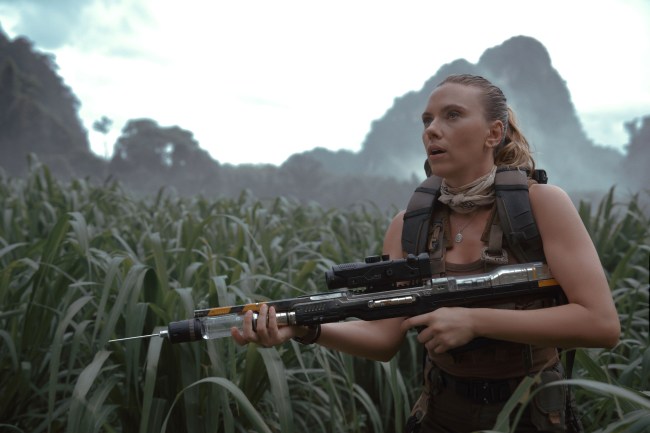David Koepp handed Universal his “Jurassic World: Rebirth” script in December 2023. In March 2024, director Gareth Edwards met with producers Frank Marshall and Steven Spielberg. Production began three months later, on June 13, 2024, and wrapped last October. For a VFX-heavy blockbuster slated for Fourth of July weekend 2025, it is a virtually unheard-of turnaround.
When Edwards was a guest on this week’s episode of the Filmmaker Toolkit podcast, he discussed how the hardest aspect of the shortened production schedule was being hired just three months before shooting.
“It was the same amount of prep I had on ‘Monsters,’ which I shot with three of us in a van,” said Edwards, referencing his 2010 festival breakout that catapulted him to becoming a studio director. “Usually you get at least two-and-a-half years from the day they call you, to the day you finish the movie.”
That was the schedule Edwards had on “Godzilla,” “Rogue One,” and “The Creator.” When Universal wanted to cut it in half for one of Hollywood’s biggest spectacle franchises, Edwards tried to push back.
“I remember day one, we went to Universal and there was Donna Langley and Peter Kramer, the heads of Universal,” said Edwards. “And I put my hand up, ‘Yeah, Gareth, at the back.’ I’m like, ‘Can we push the release date?’”
The movie that hits theaters today, only 16 months after that meeting, shows no signs of being short-changed. The action set pieces and visual effects are among the very best since Spielberg’s original. Edwards came up as a self-taught VFX artist and has the reputation for being not only one of the most innovative directors of VFX but also someone whose creative process combines conception with execution, leading to far greater efficiencies.
“I think I’ve always feel that the process is as important as the thing you’re making the product,” said Edwards. “The way you make a film is to me so fundamental, and obviously doing this movie, [we had to do that].”
Edwards brought aboard Jim Spencer, his producing partner on what he called his “two most guerilla” projects, “Monsters” and “The Creator,” but not in an effort to convert the “Jurassic Park” team to their ways.
“Early on, [Spencer and I said], ‘We can’t change the machine,” said Edwards. “If you try to fight the machine that is this massive blockbuster, the way these [are made], if you try to reinvent the process, ‘Oh, we’re not going to shoot it like this, we’re going to shoot it more like this,” and really go against it, it’s going to run over you,” said Edwards, indicating he was speaking from experience.
“I think you can change the machine, and do things differently, but there’s a limit when you’ve got a really limited timeframe with three months pre-production, getting everyone on the same page to reinvent the process massively is not possible,” he said. “It was more like, choose your battles, and my main goal was, ‘Let’s go to real locations.’”
Edwards’ philosophy: Even if those real backdrops will be significantly altered and augmented, even to the point of even no longer being recognizable, being in a real place is why his VFX-driven films feel so grounded.
That “Jurassic World: Rebirth” was able to quickly land on a main location was serendipitous. In their first meeting, Spielberg told Edwards the franchise was looking to move on from Hawaii, which represented original “Jurassic Park” locale Isla Nublar. For the nearby Ile Saint-Hubert – an equatorial island off the coast of South America, which we learn once housed a secret lab creating hybrid dinosaurs – they were scouting Costa Rica and Thailand.

“I couldn’t be better placed for this conversation because I did ‘Monsters’ in Costa Rica, and we looked high and low in that country for crazy primordial jungle scapes and beaches, and we’d just done that with ‘The Creator’ in Thailand,” said Edwards. In that first meeting, he made it clear that Thailand, specifically Phang Nga Bay, was exactly what Spielberg wanted. “So it all clicked really quickly and it probably saved us some time. I didn’t have to scout all those locations because I knew most of them.”
Visual effects supervisor and second unit director David Vickery’s team quickly shot footage of the locations, which became virtual 3D renderings that allowed Edwards and his collaborators to work virtually.
“I said to the studio when we started, ‘We’ve got three months, we cannot make a mini version of this film in pre-viz, we haven’t got time,” said Edwards. “But, then we had virtual cameras, it’s like there’s a little volume space and they set it up in the office and essentially you could see in real time, an Unreal Engine version of your ship and the [dinosaur].”
Working virtually, Edwards could go through his creative process of designing the action of a big set piece while allowing department heads to figure out what they needed to prep.
“It’s like a jigsaw puzzle where you haven’t got the box, you don’t know what the picture is, but you start going, ‘Well, we need a shot like this,’” said Edwards. “Going through the motions of shooting those shots [with a virtual camera], it then allowed other people to go, ‘I think we’re going to need a helicopter.’ ‘I think we’re going to need a drone here.’ ‘It creates all these ingredients so that the production can start to make all those things happen… It’s just like controlled chaos, really.”
Universal is releasing “Jurassic World: Rebirth” today, July 2.
To hear Gareth Edwards’ full interview, subscribe to the Filmmaker Toolkit podcast on Apple, Spotify, or your favorite podcast platform.


